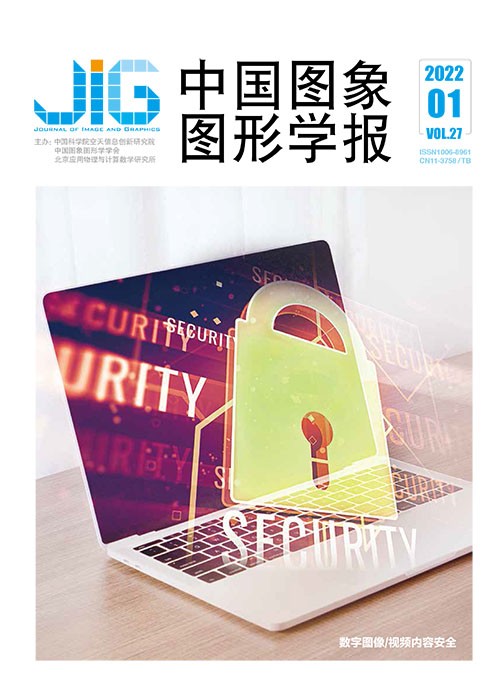
检测小篡改区域的U型网络
摘 要
目的 图像篡改区域检测是图像取证领域的一个挑战性任务,其目的是找出图像的篡改区域。传统方法仅针对某种特定的篡改方式进行设计,难以检测其他篡改方式的图像。基于卷积神经网络的方法能够自适应地提取特征,同时检测包含多种篡改方式的图像。但是其中多数方法都选择增强图像的噪声特征,这种机制无法较好处理篡改区域与原图像来源相同、噪声相似的情况。多数方法还忽略了篡改区域过小而产生的样本不平衡问题,导致检测效果不佳。方法 提出了一个基于区域损失的用于检测小篡改区域的U型网络,该网络构建了一个异常区域特征增强机制,放大与图像背景差异较大的异常区域的特征。此外,还利用区域损失增强对篡改区域框内像素的判别能力,可以解决因篡改区域过小而产生的样本不平衡问题。结果 消融实验说明了异常区域特征增强机制和区域损失机制的有效性;对JPEG压缩和高斯模糊的对抗性测试证明了模型的鲁棒性;在CASIA2.0(CASI-A image tampering detection evaluation database)、NIST2016(NIST nimble 2016 datasets)、COLUMBIA (Columbia uncompressed image splicing detection evaluation dataset)和COVERAGE (a novel database forcopy-move forgery detection)数据集上与最新方法进行比较时,本文方法取得了最优性能,其F1 score分别为0.979 5、0.982 2、0.995 3和0.987 0。结论 本文的异常区域特征增强机制和区域损失机制能有效提高模型性能,同时缓解篡改区域过小导致的样本不平衡问题,大量实验也表明了本文提出的小篡改区域检测方法的优越性。
关键词
U-Net for detecting small forgery region
Liu Liying, Wang Jinxin, Cao Shaoli, Zhao Li, Zhang Xiaoqin(Wenzhou University, Wenzhou 325035, China) Abstract
Objective Detecting the image forgery region is a challenging task on the aspect of image forensics. The statistical features and physical characteristics of the image itself methods have been focused on in the traditional detection and localization field. Traditional methods are designed only for a specific forgery, making them difficult to detect images containing diverse forgery approaches. Convolutional neural networks (CNNs) are proposed to various image tasks recently due to extracting adaptive features. Most of these methods have enhanced the noise features of an image. It cannot be qualified that the noise of the forgery region is similar to the original image. In addition, most of CNNs-based forgery region detection methods ignore the imbalanced sample constrained by the small forgery region. It affects the further improvement of detection performance. So, more qualified image features enhancement and problem solving have been focused on due to the small forgery region.Method A region loss based U-Net for small image forgery region detection is demonstrated. First, the most forgery regions differ from the image background has been investigated. Image anomaly regions could be called where differ from the image background. Splicing the difference tensor between local and dominant image features to the image to enhance the features extracted from these image anomaly regions. This feature augmentation mechanism only needs to be computed once when given an image as input, which significantly reduces training time compared to other state-of-the-art methods. Simutanesouly, a U-Net structure model is illustrated. A modified VGG-16 architecture is used to be the down-sampling part. Several de-convolution layers and convolution layers are utilized to be the up-sampling part. Aiming at retaining the location information of an image, maxpool layers is removed from the down-sampling network. To extract hierarchical features with diverse scales, the stride of last convolution layer in each down-sampling block is set as 2. The upsampling process requires fusing the multi-scale features extracted from the down-sampling process to avoid the loss of image spatial information. To address the final question caused by small forgery regions, a novel region loss has been demonstrated. The illustrated region loss mechanism requires segmenting the learning process of the network into two stages. In the first stage, the targeted binary cross entropy loss(BCELoss) of overall image as a loss function for network training. A relative rough model has been obtained. In the training process of second stage, a multiple candidate region boxes have been generated based on the location information from the model learned in first stage. The option of candidate region box should satisfy two conditions:1) The candidate region box should contain all forgery regions; 2) The ratio of forgery region and non-forgery region is approximate to 1:1. The oriented candidate region box is called forgery region box. Next, the BCELoss of the image is calculated in the forgery region box and as the second loss for the learning of second stage. Hence, the judging capability about whether pixels are forged in region box is able to be remarkable improved.Result It has the priority of the illustrated forgery region detection methods on four standard image forgery datasets, including traditional DWT method and three CNNs-based methods including manipulation tracing network(ManTra-Net), U-Net, and the ringed residual U-Net(RRU-Net). The four standard image forgery datasets are CASI-A image tampering detection evaluation database(CASIA2.0), Columbia uncompressed image splicing detection evaluation dataset(COLUMBIA), a novel database forcopy-move forgery detection(COVERAGE) and NIST nimble 2016 datasets(NIST 2016), respectively. The CASIA2.0 dataset images are small, complex and more challenging. F1 score is used as the benchmark for model evaluation. Moreover, F1 score is improved most on the CASIA2.0 dataset, which is asymptotical 2.17% higher than the second method. To test the robustness of our approach, the F1 score is evaluated as well. U-Net and RRU-Net on images is interfered by JPEG compression and Gaussian blur. The comparison results demonstrate that the method has its optimal robustness. To verify the effectiveness of the proposed feature augmentation mechanism and region loss mechanism in this work, we also perform abundant ablation experiments. Anomaly region feature augmentation modeling has its advantage and models region loss models can achieve its more qualified results.Conclusion A region loss based U-Net architecture is illustrated in order to detect forgery region in images effectively and accurately. It mainly resolves the issue of feature augmentation and small forgery regions. The difference amongst local and dominant features has been sorted out to enhance the features from image anomaly regions. An illustrated region loss enhanced the learning of features in the forgery region caused by imbalanced sample issue. Ablation study has shown that feature augmentation and region loss mechanisms improve the proposed model calculation effectively. In addition, the JPEG compression and Gaussian blur tests also demonstrate the robustness. An effective forgery region detection method is implemented and facilitated.
Keywords
image forensics small forgery region detection feature augmentation region loss convolutional neural networks(CNNs) U-Net
|



 中国图象图形学报 │ 京ICP备05080539号-4 │ 本系统由
中国图象图形学报 │ 京ICP备05080539号-4 │ 本系统由